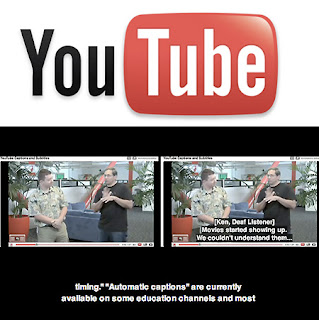
By Guest Blogger Suzanne Robitaille for
Business Week's Tech Beat. Robitaille is the founder and publisher of abledbody.com, a Web site covering assistive technology issues. She is the author of The Illustrated Guide to Assistive Technology.
Ah, video and search. Frank Sinatra said it best: Try, try, try to separate them – it’s an illusion. Here’s proof of that: Speech Technology. This week, Google sealed the deal on video search capabilities for its YouTube portal, saying it would provide auto-captions (pictured) for all of its uploaded videos using proprietary Google’s Speech Technology.
Google’s initiative, piloted in November, began with a handful of partner channels including PBS, Stanford University and National Geographic. It has now expanded to all uploaded English-speaking videos, with more languages to be added later this year.
With this news, Google establishes itself as a frontrunner in the Internet programming space. As a company built on search, search, and more search, Google is now able to capitalize on its investment in speech-to-text technology to index videos, target advertising and create an actual profit margin for YouTube. In fact, video search is likely why Google acquired YouTube in the first place.
The bigger news is that auto-captions will have clear benefits for the deaf and hearing-impaired population, who now will be able to better understand dialogue on uploaded videos. Up to now, this group had to rely on the goodwill of YouTube users to manually add captions to their videos. A time-consuming process, most users didn’t bother to do so.
At a press conference on Thursday, YouTube says accessibility is a key goal for the years to come. Even as Google touts a serious business purpose for auto-captions – search — it’s not hard to also believe in their commitment to making their products and services more usable for more of their customers.
Furthermore, Google is now removed from any ill will associated with Internet programming issues – such as the ones plaguing network and cable broadcasters. On March 17, the Federal Communications Commission will unveil a proposed broadband plan that is designed to ensure, or at least improve, equal access to Web TV and movie programming for people with disabilities, which could including requiring captions.
Meanwhile, a House congressional committee is mulling the Twenty-first Century Communications and Video Accessibility Act of 2009 that would make captions for the deaf and audio descriptions for the blind into law for Internet broadcasters. The bill is backed by nearly 240 disability organizations known as the Coalition of Organizations for Accessible Technology.
TV broadcasters – unlike Google – already have transcripts available to them – either on paper or in the form of regular TV closed captions, which have been required for almost all programming since 1990. And ABC has publicly committed to captioning all long-form content – so the heat is on everyone else.
While YouTube videos are technically outside of the FCC’s realm, consumers don’t see it that way – and they shouldn’t. That makes Google’s auto-captioning move financially savvy, and buys them consumer altruism at a time when broadcasters are facing down a potentially ugly battle over access issues.
 By Guest Blogger Suzanne Robitaille for Business Week's Tech Beat. Robitaille is the founder and publisher of abledbody.com, a Web site covering assistive technology issues. She is the author of The Illustrated Guide to Assistive Technology.
By Guest Blogger Suzanne Robitaille for Business Week's Tech Beat. Robitaille is the founder and publisher of abledbody.com, a Web site covering assistive technology issues. She is the author of The Illustrated Guide to Assistive Technology.
